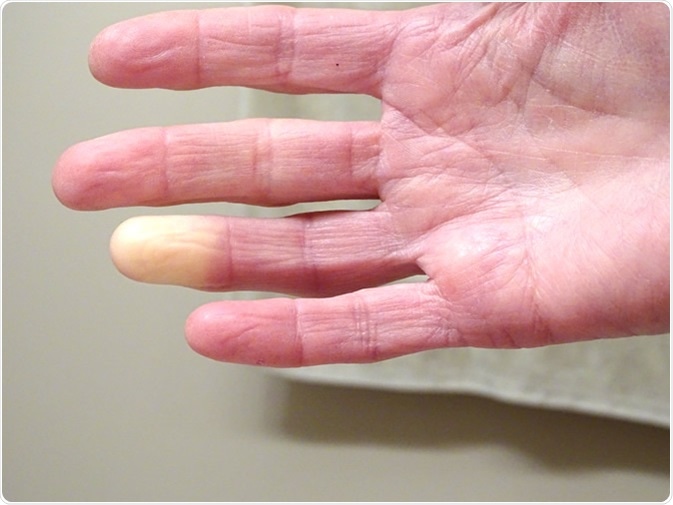If you don’t already know Fitenium is a free, mobile, video-based social network for athletes who train strength or bodyweight exercises. At Fitenium users can follow their performance, compete and get discounts in nutrition and sports equipment stores. Download it here.
Cold winters spread a number of diseases, especially those who suffer from them this season. This applies to Raynaud’s syndrome or cold hands. Today we explain the causes, symptoms and treatments.
What is Raynaud’s syndrome?
Raynaud’s syndrome is a vascular disease that causes blood vessels to spasm when exposed to stressful conditions and cold, interfering with proper blood flow not only to the fingers and toes, but also to the ears, head, and neck. nose and nipples.
The diluted arrival of blood, and therefore oxygen to the tissues, causes a cold, blue or white coloration in the fingers and other affected areas. Therefore, it is also called cold hand syndrome.
When a vasospasm occurs, blood flow can be restored and the affected area first turns red, then it can take minutes to hours to return to normal color and temperature.
 It is a rare disease and, as the Mayo Clinic experts point out, it is more common in women than in men and in people who live in cold climates.
It is a rare disease and, as the Mayo Clinic experts point out, it is more common in women than in men and in people who live in cold climates.
What causes Raynaud’s syndrome?
There are two types of Raynaud’s syndrome, depending on its cause.
Primary Raynaud’s: there is no apparent cause. Unrelated to other disorders, it usually appears before the age of 30, has mild symptoms, and heals spontaneously. It’s called Raynaud’s disease.
Secondary Raynaud’s: is due to the presence of another disorder, habit, or condition such as vascular or connective tissue disease, carpal tunnel syndrome, repetitive activities such as daily use of vibrating machines at work, blood vessels, or medications. It’s called Raynaud’s phenomenon.
Anything that causes vasoconstriction, thus preventing proper blood flow, can be the cause of secondary Raynaud’s, but there is no apparent primary cause, especially if some family members are affected. Or Raynaud’s disease may also be present.
The appearance of secondary Raynaud’s syndrome associated with an autoimmune disease is very common, as shown by studies published in the scientific journal Surgery on lupus, scleroderma and others.

Published on Unplash by Samantha Gades
Symptoms of Raynaud’s syndrome
As mentioned, the biggest trigger for Raynaud’s syndrome is cold temperatures. For example, opening the fridge, wetting your hands with cold water or touching frozen glass or frozen food. Also some stressful situations.
Among the main symptoms are blue or white tones in the fingers of the hand and even in the palm. It can also occur on the toes, ears, and nose.
The affected area may also experience tingling, numbness, and pain, the latter not often later.
Since the symptoms are caused by the limited supply of blood and oxygen, in severe cases there may be tissue damage, with ulceration and death of the tissues if the affected area does not receive blood for a considerable time.
After the episode that produces this high sensitivity to cold, the affected area usually presents redness and a burning sensation as blood flow is restored.
This is how Raynaud’s syndrome is treated
If you have a typical attack of Raynaud’s syndrome (blue or white in the hand and its numbness), the basic idea is that each capillary episode becomes narrower as each capillary becomes narrower and narrower in the hands and fingers. . I will be serious.

Published on Unplash by Gervyn Louis
Therefore, it is advisable to wear gloves and socks, especially when opening the room or the freezer, to avoid exposure to cold, especially on the extremities.
If you are facing the signs of a new attack, you can prevent it by washing your hands with lukewarm water. In addition, it is important to always sleep with gloves, covered gloves or socks to avoid night attacks in case of temperature changes.
The important thing is to stay away from the cold to prevent new attacks that can cause serious complications over time.
Using insulated glass to set your air conditioner to a higher temperature in the summer and keep warm in the winter is also essential for maintaining control of Raynaud’s syndrome, which can lead to drugs and stressful situations that can lead to seizures. Deleting is also important.
As the American scientists point out, surgery to avoid nerve stimulation in the face of cold does not seem to be effective for Raynaud’s syndrome, but it can cause seizures typical of the disease. Cold weather can be avoided for the worse in the coming winter.
References | Surgery [1976 Dec 1, 80(6):756-764] and American Journal of Surgery, Volume 142, Number 2, Aug 1981, Pages 183-189.



